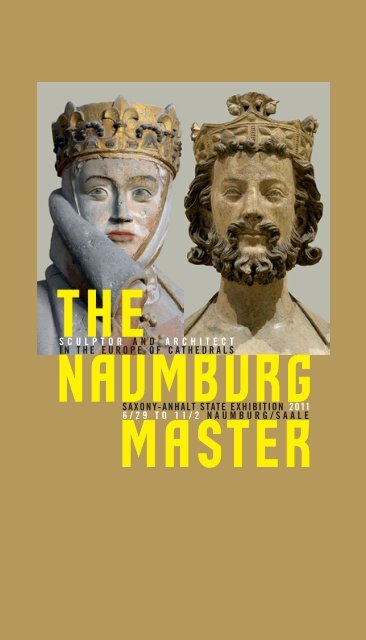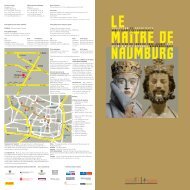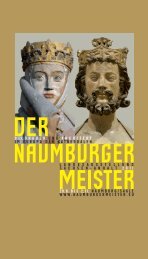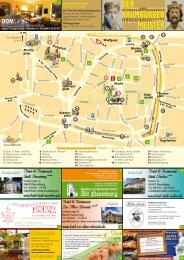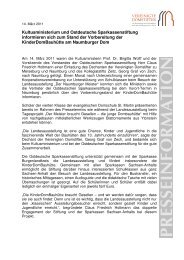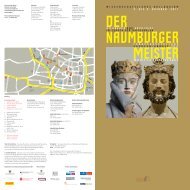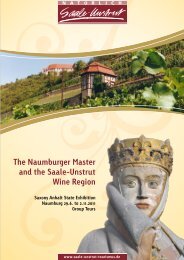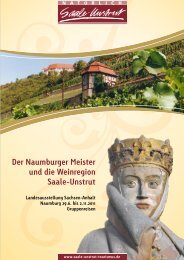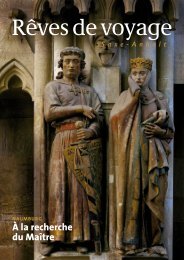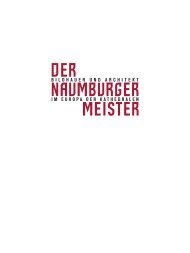Untitled - Der Naumburger Meister
Untitled - Der Naumburger Meister
Untitled - Der Naumburger Meister
Create successful ePaper yourself
Turn your PDF publications into a flip-book with our unique Google optimized e-Paper software.
Organisers of the exhibition<br />
represented by<br />
Georg Graf von Zech-Burkersroda,<br />
Dean of the Chapter<br />
Principal sponsors of the Saxony-Anhalt State exhibition 2011<br />
Additional support<br />
Partners and supporters<br />
SEKTKELLEREI<br />
In cooperation with Musée du Louvre Paris; Musée des Monuments français Paris;<br />
Musée National du Moyen Âge Paris; Musées de la Ville de Strasbourg; Bischöfliches<br />
Dom- und Diözesanmuseum Mainz; Hochstift Meißen; Landesamt für Denkmalpflege<br />
und Archäologie Sachsen-Anhalt; Evangelisches Kirchspiel Naumburg; Domkantorei<br />
Naumburg; NAUMBUrG KoLLEG; LISA Landesinstitut für Lehrerfortbildung,<br />
Lehrerweiterbildung und Unterrichtsforschung; Theater Naumburg<br />
Enjoy a visit to “<strong>Der</strong> verschwundene Dom” (The vanished cathedral),<br />
a special exhi bition by Bischöfliches Dom- und Diözesanmuseum Mainz on<br />
the occasion of the Mainz Cathedral’s 1000-year anniversary from<br />
1st April to 31st october 2011<br />
“From Naumburg to Meissen”, a special exhibition by the Hochstift Meissen<br />
from 29th June to 2nd November 2011 in Meissen Cathedral<br />
Contact<br />
Exhibition office<br />
fon +49 (0) 3445 23 01 123<br />
info@naumburgermeister.eu<br />
represented by<br />
the Mayor Bernward Küper<br />
Public relations<br />
fon +49 (0) 3445 23 01 122<br />
presse@naumburgermeister.eu<br />
Under the generous auspices<br />
of the Chancellor<br />
of the Federal republic of Germany,<br />
Dr. Angela Merkel
T h e N a u m b u r g m a s T e r –<br />
sculpTor aNd archiTecT iN The europe of caThedrals<br />
The “Schlösschen”<br />
on the marketplace<br />
in front of the Church<br />
of St. Wenceslas<br />
Naumburg City Museum<br />
“Hohe Lilie”<br />
on the marketplace<br />
Entitled “The Naumburg Master –<br />
Sculptor and Architect in the Europe<br />
of Cathedrals”, the Saxony-<br />
Anhalt State Exhibition will be presented<br />
in Naumburg from 29th June<br />
to 2nd November 2011. It is organized<br />
by the city of Naumburg in cooperation<br />
with the United Chapters<br />
Foundations of the Cathedrals of<br />
Merseburg and Naumburg and the<br />
collegiate Chapter of Zeitz (Vereinigte<br />
Domstifter zu Merseburg und<br />
Naumburg und des Kollegiatstifts<br />
Zeitz).<br />
In close cooperation with a large<br />
number of museums, institutions<br />
and specialists from Germany and<br />
abroad, this international exhibition<br />
is dedicated to the work of the so<br />
called Naumburg Master and his ar-<br />
tistic position in the context of mid<br />
13th century Europe. outstanding<br />
works of art - including sculpture,<br />
treasury objects in gold and silver,<br />
stained glass and illustrated books<br />
from France, Germany, Poland, the<br />
United Kingdom, Austria and the<br />
USA – provide a unique insight and<br />
understanding of cultural and artistic<br />
exchange in medieval Europe.<br />
2 3<br />
Naumburg, apex of<br />
St. John‘s Chapel<br />
in the cathedral cemetery<br />
Naumburg, Chapel of St. Giles<br />
in a canon‘s house<br />
An exhibition area of 2500m² will be<br />
used, including the “Schlösschen“<br />
on the market place, the Cathedral<br />
of St. Peter and St. Paul, the Church<br />
of St. Mary near the Cathedral, and<br />
the city museum “Hohe Lilie”. The<br />
St. John’s Chapel in the Cathedral<br />
cemetery as well as the St. Giles’<br />
Chapel await the visitor. In addition<br />
to the exhibition space a highlight<br />
shall be the redesigned Cathedral<br />
garden including the children’s medieval<br />
stone masons’ lodge and the<br />
“Garden of the Naumburg Master” –<br />
a recreation of a medieval garden<br />
where the natural plant world which<br />
inspired the sculptor for the capitals<br />
of the rood screen in the Cathedral<br />
can be admired.
Naumburg caThedral<br />
The towers of the cathedral<br />
from the south west<br />
Naumburg Cathedral crypt<br />
under the east choir<br />
The Naumburg Cathedral of St. P eter<br />
and St. Paul ranks as one of the most<br />
important sacred cultural monuments<br />
from the time of the European<br />
High Middle Ages. Together with<br />
the cloisters, the chapel of the Three<br />
Kings, the Church of St. Mary and<br />
the surrounding canons’ houses, the<br />
impressive building with its four<br />
towers creates a magnificent architectural<br />
ensemble.<br />
The history of Naumburg Cathedral<br />
begins in 1028 with the transfer of<br />
the Bishop’s seat to Naumburg from<br />
Zeitz, which was founded by Em-<br />
peror otto the Great in 968. With<br />
the exception of a few remaining<br />
remnants of several walls, little is left<br />
of the 11th century cathedral.<br />
Sources indicate comprehensive<br />
building work on the cloisters and<br />
the cathedral church from 1211-1212<br />
at which time the decision was made<br />
for an ambitious rebuilding of the<br />
cathedral. By the time of the death of<br />
Bishop Engelhard II in 1242, the<br />
crypt, the east choir, the transept,<br />
nave and the ground floor of the two<br />
west towers had been completed.<br />
4 5<br />
Naumburg Cathedral<br />
nave looking towards the west<br />
with a view of the west rood screen<br />
and west choir
i s h o p d i e T r i c h i i<br />
a N d T h e c o N s T r u c T i o N<br />
o f T h e w e s T c h o i r<br />
Statues of Ekkehard II,<br />
Margrave of Lusatia and Meissen<br />
and his consort Uta<br />
6 7<br />
Charter from 1249: appeal<br />
for the completion of the cathedral<br />
Naumburg, Domstiftsarchiv<br />
Statue<br />
of Count Syzzo<br />
The decisions made by Bishop Dietrich<br />
II (1243–1272) had a major<br />
i nfluence on the history of Naumburg<br />
Cathedral. Being a member of<br />
the House of Wettin as well as being<br />
a long term member of the Naumburg<br />
Cathedral chapter, Dietrich maintained<br />
a special and intermediary<br />
p osition in the tense network woven<br />
between the claims to power of the<br />
diocese and the attempts to contain<br />
and restrict diocesan power on the<br />
part of Margrave Henry the Illustrious<br />
of Meissen (1221–1288). Siegfried<br />
II, Archbishop of Mainz, ordained<br />
Dietrich II as bishop. This<br />
direct contact was a major contributing<br />
factor leading to the summons<br />
to Naumburg of the artist who had<br />
created the rood screen in the Cathedral<br />
of Mainz. The cooperative<br />
e fforts of Bishop Dietrich II, various<br />
representatives of the cathedral<br />
chapter, and the master craftsman<br />
from Mainz resulted in the agreement<br />
to complete the west choir of<br />
the cathedral and by so doing to fundamentally<br />
and symbolically manifest<br />
the secular and ecclesiastic legality<br />
of Naumburg as Bishop’s Seat.<br />
For this reason, it was the further<br />
agreed upon to commission a group<br />
of twelve statues: one each of twelve<br />
various benefactors who had endowed<br />
and gifted the Naumburg<br />
Cathedral. These twelve statues<br />
form the artistic basis of the west<br />
choir itself, all of which is embedded<br />
in a highly complex and comprehensive<br />
theological concept.
View<br />
of the<br />
west choir<br />
T h e w e s T c h o i r – a uNique eNsemble<br />
Christ before Pilate, relief<br />
on the west rood screen<br />
Due to their excellent artistic quality,<br />
the architecture, sculpture, stained<br />
glass and fresco of the west choir<br />
(completed approximately 1250)<br />
create a synthesis which is completely<br />
unified in both its iconographical<br />
and structural engineering aspects.<br />
This extraordinary artistic, architectural,<br />
and theological harmony can<br />
only have been achieved by giving a<br />
general directorship of the worksite<br />
to one responsible sculptor/architect<br />
– the “Naumburg Master” who<br />
came from Mainz.<br />
The composition of the Crucifixion<br />
group and the related reliefs detailing<br />
the Passion on the west rood<br />
screen, the design of the twelve benefactor<br />
figures in the west choir, as<br />
well as the deacon’s statue in the<br />
form of a pult-bearer, and the bishop’s<br />
monument tomb in the east<br />
choir – are all of consumate artistic<br />
mastery. Faces, gestures and movements<br />
are reproduced in an unusually<br />
lifelike and expressive manner.<br />
The extraordinary ability of the artist<br />
to give to all of his human figures<br />
a realistic expression of emotional,<br />
spiritual, and psychological conditions,<br />
imbues the figures with an inner<br />
life and soul. The uniquely realistic<br />
representations of plants in the<br />
capitals of the rood screen and those<br />
of humans and animals on the gargoyles<br />
of the west choir are examples<br />
of the astonishing naturalism of<br />
the Naumburg Master. Firmly anchored<br />
within an architectural<br />
framework, the statues of the benefactors<br />
in the west choir are spatially<br />
related to the Crucifixion group and<br />
the reliefs depicting the Passion on<br />
the west rood screen. In turn, these<br />
8 9<br />
figures and depictions are all in an<br />
immediate compositional relationship<br />
and interaction with the fresco<br />
of the Supreme Judge in the quatrefoil.<br />
In harmony with the depictions<br />
of the Naumburg Bishops and the<br />
saints triumphal over vice in the<br />
stained glass windows, the entire artistic<br />
and architectonic complex of<br />
the west choir manifests the central<br />
statement of faith in the theology of<br />
the High Middle Ages.<br />
How medieval works of art from<br />
various genres were compositionally<br />
Front view of the west<br />
rood screen<br />
Detail of St. John<br />
from the Calvary scene on<br />
the west rood screen<br />
Detail of the Virgin Mary<br />
from the Calvary scene on<br />
the west rood screen<br />
unified in order to express to believers<br />
an idea of salvation can still be<br />
examined today by virtue of the ensemble<br />
of sculpture, stained glass<br />
and painting in the west choir. Based<br />
upon the medieval ideal of creating<br />
an organic art work, the exhibition<br />
offers a survey of stylistic and programmatic<br />
relationships within the<br />
various genres of medieval art with<br />
comparative presentations of manuscripts,<br />
gold and silver objets d’art,<br />
and stained glass.
life aNd worK of The Naumburg masTer<br />
The Founders’ bay and the choir<br />
polygon in Meissen Cathedral<br />
As there are no written sources as to<br />
the life of the Naumburg Master, research<br />
into the history and work of<br />
the anonymous sculptor/architect<br />
and his workshop is dependent on<br />
the results of architectural research<br />
and artistic analysis. However, the<br />
results of this research and analysis<br />
indicate and recognize that the<br />
Naumburg Master is one of the most<br />
important sculptor/architects in Europe,<br />
embedded in a wide stream of<br />
east and west cultural exchanges. In<br />
the form of originals and copies, the<br />
exhibition in Naumburg manages to<br />
bring together a large number of<br />
works which manifest this cultural<br />
exchange so inherent to the art and<br />
architecture of mid 13th century Europe.<br />
As well as being based on the<br />
architect’s places of residence before<br />
and after Naumburg – Mainz and<br />
Meissen – it presents the foundation<br />
of the “Naumburg” workshop and<br />
its forerunners in reims, Noyon,<br />
Coucy and Metz.<br />
The Master’s specifi c style can be<br />
seen for the fi rst time in the west<br />
front of Noyon Cathedral, and also<br />
perhaps in the sculptural decorations<br />
of the donjon of the fortress of<br />
Coucy, the largest castle complex in<br />
France in the 13th century. Furthermore,<br />
he created in the Cathedral<br />
of Metz an artistically outstanding<br />
r elief.<br />
The appointment of the Master’s<br />
workshop by Siegfried III of Eppstein,<br />
Archbishop of Mainz, played<br />
an important part in the Master’s<br />
work within the Holy roman Empire.<br />
His work on the west and east<br />
choirs of Mainz Cathedral may have<br />
been contemporary to the design<br />
10 11<br />
and construction of the Templars’<br />
chapel in Iben in the rhineland. His<br />
capability as an architect was comprehensively<br />
demonstrated with the<br />
complete design of the west choir at<br />
Naumburg, and with the bold and<br />
complex site of the Cathedral at<br />
Meissen, the substructure of which<br />
extends deep down a steep cliff.<br />
Atlas, supporting<br />
sculpture on the west front<br />
of Noyon Cathedral<br />
Procession of the damned<br />
on Judgment Day<br />
on the former west rood<br />
screen of Mainz Cathedral<br />
Mainz, Dom-und<br />
Diözesanmuseum<br />
Division of the coat<br />
of St. Martin in the parish<br />
church of Bassenheim
Choir<br />
of Notre-Dame<br />
Cathedral<br />
in reims<br />
reims<br />
The coroNaTioN caThedral<br />
of The KiNgs of fraNce<br />
From the time that remigius, Archbishop<br />
of reims anointed Chlodwig,<br />
King of the Franks at the end of the<br />
5th century in the cathedral, the<br />
c athedral at reims played a prominent<br />
role in the establishment and<br />
formation of the west Frankish –<br />
l ater French – kingdom. The new<br />
c athedral, which was built following<br />
a devastating fi re in 1211, refl ects the<br />
confi dence and the tradition of both<br />
the most important French archbishopric<br />
and the ambitious royal<br />
dynasty. New forms in sculpture<br />
and architecture are witnesses to the<br />
innovative power that spread out<br />
from the most infl uential cathedral<br />
building site of the time. Masks and<br />
tracery are the main elements for the<br />
individualization of the sculpture<br />
and the artistic sophistication of the<br />
building. From the beginning, architecture<br />
and sculpture were integrated<br />
in a hitherto unknown way – the<br />
origins of the “sculptor/architect”<br />
began here.<br />
12 13<br />
T h e i N f l u e N c e<br />
of reims caThedral<br />
The redeemed sinners in Abraham‘s bosom<br />
from the Prince‘s Porch of Bamberg Cathedral<br />
Bamberg, Diözesanmuseum<br />
The building of reims Cathedral<br />
was a magnet for stonemasons,<br />
a rchitects and craftsmen from all<br />
over Europe. owing to the rapidity<br />
of construction and the gigantic size<br />
of the undertaking, there was a high<br />
turnover of highly specialized workers.<br />
The groups of workers who<br />
moved from reims spread the new<br />
knowledge of architecture, sculpture<br />
and logistics throughout most<br />
of the Christian countries within a<br />
very short time. Using prominent<br />
originals and copies, the exhibition<br />
indicates the triumphal procession<br />
of this new style in Strasbourg,<br />
Trier, Bamberg and Magdeburg. And,<br />
the artistic and architectural sources<br />
which inspired the Naumburg Master<br />
are also a central theme of the<br />
e xhibition.<br />
Eve with the distaff,<br />
fi gure from the rose archivolt<br />
in the north transept<br />
of reims Cathedral<br />
reims, Palais du Tau<br />
Head of an angel<br />
Trier, rheinisches<br />
Landesmuseum
Atlas from Strasbourg Minster<br />
Strasbourg, Musée<br />
de l’Œuvre Notre-Dame<br />
The masTer builders of<br />
The goThic caThedrals<br />
Baptismal font from Hildesheim Cathedral<br />
Hildesheim, Cathedral of the Assumption of the<br />
Virgin Mary<br />
During the course of the 13th century,<br />
with the building of cathedrals<br />
that seemed to reach towards heaven,<br />
the scale of which transcended all<br />
building that had hitherto been conceived<br />
– including those of antiquity,<br />
the social status of the architect<br />
changed. Entrusted with development<br />
of construction to the highest<br />
standards, he was considered to be a<br />
“doctor lathomorum”, a highly qualifi<br />
ed stonemason. The names of the<br />
sculptor/architects of these new,<br />
massive buildings were often immortalized<br />
in the labyrinths, a symbol<br />
of pre-eminent architecture,<br />
which were inlaid in the stone fl oors<br />
of the cathedrals.<br />
Architectural sketches drawn on<br />
parchment were then passed from<br />
one building site to another builidng<br />
site which allowed the sculptor/architect<br />
to comprehensively study,<br />
analyse, and understand both his<br />
own and other building projects in<br />
their various stages. Microarchitectural<br />
positions, such as baldachins<br />
over fi gures, mirror, in a model-like<br />
manner, ideals of architecture. The<br />
“atlantes”, statues of the master<br />
builder often found fi guratively supporting<br />
an architectural element<br />
within the building are allegories of<br />
the humble, modest, and servile relationship<br />
of the master builder to his<br />
physically and spiritually overwhelming<br />
creation: the cathedral.<br />
14 15<br />
arT aNd academia –<br />
paradise regaiNed<br />
Capital with vines<br />
on the west rood screen<br />
of Naumburg Cathedral<br />
The foundation of universities in<br />
Europe – especially that in Paris<br />
around 1150 – brought about a new<br />
scientifi c understanding. The writings<br />
of the philosophers from antiquity<br />
were rediscovered: in particular<br />
those of Aristotle, which formed<br />
the basis of scholastic teaching. As a<br />
r esult of the thoughts and writings<br />
of Albertus Magnus, the Dominican<br />
friar from Cologne, scientifi c research<br />
concerning nature changed.<br />
research was now exclusively concentrated<br />
on visual experience.<br />
This empirical principle also fi nds its<br />
expression in art, in the naturalistic<br />
depiction of fl ora and fauna in the<br />
decoration of the capitals and in<br />
friezes of foliage. The plants on the<br />
Scenes from the life<br />
of Parisian pupils<br />
Paris, Archives nationales,<br />
recueil des titres de<br />
fondation du collège de Hubant<br />
west rood screen capitals in Naumburg<br />
are of particularly impressive<br />
vitality. In light of the sacrifi cial<br />
death of Christ as depicted on the<br />
west rood screen these plants symbolize<br />
the redemption of the entire<br />
cosmos. observation of nature is extended<br />
to humans and animals in the<br />
same way. Emulating the famous<br />
“masks” of rheims Cathedral, which<br />
are based on physiognomic studies,<br />
attempts were made in many locales<br />
to convey a sense of inner life in the<br />
rendering of faces. owing to this increased<br />
visual awareness and experience<br />
of nature, even mythical beings<br />
such as dragons appear to have a real<br />
existence.<br />
ornamental leaves<br />
from the rood screen<br />
in Chartres Cathedral<br />
Chartres, Kathedrale<br />
Notre Dame
siN aNd redempTioN –<br />
The humaN face of chrisT<br />
The crucified Christ<br />
at the entrance<br />
to the west rood screen<br />
in Naumburg Cathedral<br />
16 17<br />
Platter with the head<br />
of John the Baptist<br />
Naumburg,<br />
Treasury Vault<br />
The Eucharistic Christ<br />
private loan,<br />
Wolfenbüttel, Herzog<br />
August Bibliothek<br />
The concept of distinctive individual<br />
knowledge of guilt, combined with<br />
the question of the possibility of<br />
freeing oneself from the yoke of sin<br />
through one’s own efforts pervades<br />
the entire gothic time period. However,<br />
it was simultaneously maintained<br />
that it was possible to obtain<br />
salvation through the church. This<br />
salvation occurred, for example,<br />
by presenting endowments to the<br />
church or churchrelated institutions,<br />
and by so doing, avoiding eternal<br />
damnation. The representations on<br />
the rood screen point to the act of<br />
redemption though the crucifixion<br />
of Christ, which was mystically<br />
reenacted in the celebration of the<br />
Eucharist at the choir altar. The<br />
prayers of the congregation included<br />
the benefactors portrayed in the<br />
statues on account of their good<br />
deeds.<br />
The concept of salvation on the<br />
Judgement Day with a punishing<br />
God permeated cathedral sculpture<br />
of the first half of the 13th century.<br />
In the work of the Naumburg M aster<br />
the grace endowing Christ a ppears<br />
instead. Those entering the choir at<br />
the west rood screen confront the<br />
Saviour directly in a powerful manner<br />
that is not to be found in cathedrals<br />
either before or since. Many<br />
and various statues and reliefs of the<br />
13th century, in places far removed<br />
from one another, artistically indicate<br />
the theological concept of a<br />
spiritually renewed and noble humanity.
courTly culTure aNd<br />
The commemoraTioN of fouNders<br />
The Ascanians‘ Chalice<br />
Berlin, Evangelische<br />
Kirchengemeinde<br />
St. Petri und St. Marien<br />
Golden brooch from the<br />
Erfurt treasure trove<br />
Thüringisches Landesamt<br />
für Denkmalpflege und<br />
Archäologie<br />
Influenced by developments in<br />
France and England, a high culture<br />
of courtly nobles flourished in Saxony<br />
and Thuringia in the 13th century,<br />
and found expression in poetry and<br />
music as well as the fine arts. In the<br />
same context an concept of spiritual<br />
salvation developed which was artistically<br />
represented with the assistance<br />
of an hierarchically organized<br />
classification system, as seen for example,<br />
in the west choir of the<br />
Naumburg Cathedral. The sculptures<br />
of the founders in Naumburg<br />
evoke the characteristics and distinctions<br />
developed by and inherent to<br />
the knightly class since the 12th century.<br />
These class characteristics and<br />
distinctions were to be seen in weaponry,<br />
heraldry, costume and jewellery,<br />
and particularly in the standards<br />
of courtly behaviour.<br />
Tomb figure of Margrave<br />
Dietrich of Meissen (died 1307)<br />
Leipzig, Kustodie der Universität<br />
In this epoch, the commemoration<br />
of cathedral founders via an artistic<br />
process increased considerably.<br />
Founders and benefactors often long<br />
dead were memorialized in the form<br />
of monuments or, as in Naumburg,<br />
as statues. These memorials serve as<br />
a reminder of the everlasting, perpetual<br />
powers as well as the venerable<br />
age of ecclesiastic institutions. In the<br />
statues of the founders, intended as<br />
models to emulate, the prospect and<br />
promise of salvation appears to be<br />
honoured by good works.<br />
18 19<br />
sacred figures<br />
iN colour aNd lighT<br />
Mary Magdalene<br />
in the north window<br />
of the west choir of<br />
Naumburg Cathedral<br />
Christ‘s descent into hell<br />
The Wolfenbüttel<br />
Pattern Book,<br />
Herzog August Bibliothek<br />
Wolfenüttel<br />
The resurrection<br />
Hamburg, Staats-und<br />
Universitätsbibliothek,<br />
Cod. 1 in scrinio<br />
The stained glass windows of the<br />
west choir, which to a large extent<br />
have survived in their original condition,<br />
have not hitherto been sufficiently<br />
valued or recognized for<br />
their artistic importance. Their artistic<br />
importance, however, the windows<br />
should be as much appreciated<br />
as the sculpture and the architecture,<br />
whereby the images in the windows<br />
have completely different origins.<br />
The “Zackenstil”, which spread<br />
from the rhineland to North and<br />
Central Germany, is based upon<br />
Byzantine motifs. As the “Wolfenbüttel<br />
pattern book” indicates, these<br />
various patterns were formalised and<br />
compiled in Constantinople. The exhibition<br />
highlights the significance<br />
of the Naumburg stained glass,<br />
which is then compared to a selection<br />
of unique examples of stained<br />
glass and illustrated manuscripts.
caThedral rood screeNs<br />
iN The 13Th ceNTury<br />
The representation of the Passion of<br />
Christ on the rood screen is a key<br />
position within the overall concept<br />
in Naumburg. The sacrificial death<br />
on the Cross is the source of redemption<br />
for the penitent. Who wished to<br />
further the salvation of his soul could<br />
do so by contributing to the church<br />
in the form of financially-oriented<br />
endowments. The Passion of our<br />
Lord is a particularly common theme<br />
on other rood screens from the 13th<br />
century, an architectural barrier<br />
which separates the congregation in<br />
the nave from the clergy in the choir.<br />
Fragments of complete and identifiable<br />
rood screens of France and the<br />
rhineland will be placed alongside<br />
the work of the Naumburg Master.<br />
The dream of the Three Wise Men,<br />
relief from the rood screen in<br />
Chartres Cathedral<br />
Notre-Dame Cathedral, Chartres<br />
The sacrifice of Isaac, relief from the<br />
rood screen of Strasbourg Minster<br />
Strasbourg, Musée de l’Œuvre<br />
Notre-Dame<br />
Mary Magdalene<br />
from the rood screen of<br />
Amiens Cathedral<br />
Amiens, Musée du Picardie<br />
20 21<br />
a New courTly ideal – arT<br />
uNder sT. louis of fraNce<br />
King Childebert I, statue from the Abbey<br />
of Saint-Germain-des-Prés in Paris<br />
Paris, Musée du Louvre<br />
The complex development of courtly<br />
aspects and the associated physical,<br />
human appearances seen within<br />
the sculptural cycle of the Cathedral<br />
Founders in Naumburg are determined<br />
by and are a reception of artistic<br />
ideas and forms firstly manifested<br />
at the Cathedral of rheims.<br />
These particular stylistic forms and<br />
modelling are indubitably a reception<br />
of rheims, and yet these forms<br />
were also rooted in the cultural heritage<br />
and objectives of the commissioners<br />
of the statues in Naumburg.<br />
So palpable in the Naumburg benefactor<br />
statues, the artistic ideal and<br />
objective of creating unique, individual,<br />
human forms shall find in<br />
Naumburg and in Meissen its final<br />
expression.<br />
A unified standardization replaced<br />
the goal of artistically registering<br />
and portraying individual traits: a<br />
direct result of a uniforming and<br />
unifying of courtly etiquette and life<br />
under Louis IX of France, commonly<br />
referred to as Saint Louis (1226–<br />
1270). Within this courtly context, a<br />
sophisticated elegance was developed.<br />
In association with this new<br />
codification of courtly life and towards<br />
the middle of the 13th century<br />
in Paris, a concept of art was developed<br />
that henceforth would dominate<br />
taste throughout much of Europe.<br />
In the exhibit, works of art<br />
carried out in France at this time or<br />
inspired by the French model illustrate<br />
this new concept of art.<br />
The exhibition presents major works<br />
produced at this time in Paris, among<br />
them the statue of King Childebert<br />
from the abbey of Saint-Germaindes-Prés<br />
and the apostles from Sainte-<br />
Chapelle. The Sainte-Chapelle, a central<br />
building project under Louis IX,<br />
was built at this time to house the<br />
r elic of Christ’s crown of thorns<br />
which Louis IX had acquired. The<br />
Sainte-Chapelle was erected as a<br />
“transparent” home for this extraordinary<br />
relic at the same time as the<br />
Naumburg west choir and also, in the<br />
interior, contains a cycle of statues.<br />
Apostle from the cycle of<br />
statues in Sainte-Chapelle<br />
Paris, Musée National<br />
du Moyen Âge
iNTerpreTaTioNs of The<br />
Naumburg caThedral: pasT aNd preseNT<br />
Evil Queen<br />
Scene from the DVD<br />
“Snow White and the seven Dwarfs”<br />
© Disney<br />
Without a doubt, Naumburg Cathedral<br />
and the work of the Naumburg<br />
Master are unique. And yet it could<br />
be maintained that there are as many<br />
Naumburg Cathedrals, as many Utas<br />
and Ekkehards and as many Naumburg<br />
Masters to be found as there<br />
are viewers, readers and scholars<br />
who study them.<br />
For a good 150 years art history has<br />
been concerned with the “stone marvel”<br />
of Naumburg with multifarious<br />
and often contradictory results. Popular<br />
reception – at that time vehement<br />
– began at the end of the 1920s<br />
with a flood of publications and reproductions,<br />
among which the expressive<br />
photographs by Walter Hege,<br />
a native of Naumburg and a pioneer<br />
in the photography of architecture<br />
and nature, played a central<br />
part.<br />
A diversity of interests of problematic<br />
contradictions (romanesque/<br />
Gothic, introverted/extroverted, Ger -<br />
man/French etc.) provided the matrix<br />
for a kaleidoscopic mix of pictures:<br />
the “Master” as a born again<br />
Pygmalion, as a wandering genius, as<br />
God seeking mystic, as a Waldensian<br />
heretic, and finally as a prosaic collective<br />
of stonemasons. Uta, whose<br />
fame soon outstripped the fame of all<br />
the other Naumburg likenesses, has<br />
been portrayed as a faithful wife, as<br />
an unapproachable aristocrat and as a<br />
mysterious diva.<br />
The Naumburg statues have been<br />
abused as a symbol of the would be<br />
superiority of the Germans over everything<br />
foreign; while the reproductions<br />
in plaster and clay in West German<br />
living rooms after the World<br />
War II served as a reminder of their<br />
compatriots in the East. Today the<br />
Naumburg Master and his works appear<br />
to stand for European integration,<br />
a concept which had already<br />
been achieved in the Middle Ages.<br />
22 23<br />
The first illustration of Ekkehard and Uta<br />
(detail). Copper Engraving from: Johann<br />
Schamelius. Historische Beschreibung von<br />
dem ehemals berühmten Benedictiner-<br />
Kloster zu St. Georgen. Naumburg 1728<br />
“A culture fights for its existence”.<br />
Uta as an icon of World War II<br />
perseverance and endurance rallying<br />
speeches, from: “Kultur-Sonderausgabe”<br />
of the Leipziger Illustrierten Zeitung,<br />
December 1944<br />
Uta in the Cold War: as allegory of the “Eastern<br />
Colonisation” as seen on a German Federal Post<br />
stamp released during the annual conference of<br />
the East German Cultural Council in Berlin-West,<br />
1957<br />
The entertaining part of the exhibition<br />
in the City Museum “Hohe<br />
L ilie” (a building that dates back to<br />
the middle of the 13th century) is<br />
concerned with the interesting question<br />
of how such constructs of interpretation<br />
are formed and what manifest<br />
results they have produced. Under<br />
what conditions can works of art<br />
which are totally alien to the modern<br />
world be brought to life? How do<br />
the pictures appear in the eyes of the<br />
beholder? What do these works contribute<br />
to the process of interpretation?<br />
What does the beholder bring<br />
with him? And how much is owing<br />
to the “spirit of the age”?
Anemone ranunculoides L.,<br />
ranunculaceae: Buttercup flower,<br />
yellow anemone<br />
The Naumburg Cathedral garden<br />
surrounds a large area immediately<br />
to the southwest of the Cathedral.<br />
This garden of approximately two<br />
and a half acres invites the visitor to<br />
stroll and enjoy the park, and perhaps<br />
indulge in a cup of coffee.<br />
Until the opening of the 2011 exhibit,<br />
this area of the Cathedral grounds<br />
was not open to the public. Unified<br />
within it are historic pond and pool<br />
complexes, the bastions of the medieval<br />
“Immunity Walls”, as well as<br />
the gardens of the former homes of<br />
the canons.<br />
The gardeN of The Naumburg masTer<br />
Naturalistic capital on the Western<br />
rood screen in Naumburg Cathedral<br />
In harmony with the newly redesigned<br />
Cathedral Garden, the garden<br />
of the Naumburg Master manages<br />
to create a relaxing and atmospheric<br />
ambience in which the Cathedral<br />
itself is situated and embedded.<br />
Within the park complex, in close<br />
proximity to the west Choir, the<br />
“Garden of the Naumburg Master” is<br />
situated in which the visitor may<br />
study and admire the local plant<br />
world. Exactly these plants served to<br />
inspire the Naumburg Master; he<br />
used these plants as models for the<br />
capitals, the friezes, and the keystones<br />
of the west rood screens and<br />
the west choir. on both the west<br />
rood screen and in the west choir of<br />
the Cathedral are over 150 original<br />
capitals on which botanically correct<br />
and identifiable foliage are to be<br />
found.<br />
24 25<br />
Cathedral stonemason's<br />
hut for children<br />
Naumburg Cathedral garden<br />
North Cathedral Sqaure<br />
Within the grounds of the Cathedral<br />
garden and in the course of the Exhibition<br />
a recreation of a medieval<br />
a rtisans’ and artists’ workshop (Bauhütte)<br />
shall be opened in which visitors<br />
may study and experience both<br />
the administrative and artistic processes<br />
of building and creating a<br />
m edieval Cathedral. Here visitors<br />
may experience, for example, the<br />
creation of a copy of a statue of a<br />
founding cathedral capital member<br />
such as Uta or Ekkehard, perhaps<br />
the most wellknown of the twelve<br />
figurative sculptures.<br />
Moreover, the Naumburg Cathedral<br />
garden will be the location of many<br />
artistic performances. Here the<br />
Naumburg Theatre will perform the<br />
special highlight “Lichtschatten tänzer”<br />
with figures, masks, music and<br />
dance.<br />
Garden of the<br />
g<br />
a<br />
l<br />
Naumburg Master<br />
e<br />
b<br />
h<br />
c<br />
u<br />
r<br />
b<br />
n<br />
i<br />
e<br />
t<br />
S<br />
3 Stg. 15/33<br />
4 Stg. 15/33<br />
5 Stg. 15/33<br />
West choir<br />
West enclosure<br />
Cathedral<br />
South enclosure<br />
The following sponsors and<br />
patrons have financed the<br />
reconstruction and restoration<br />
of the Naumburg Cathedral<br />
garden:<br />
St. Mary's Church<br />
Marienkapelle<br />
Cathedral Square<br />
Höhe Bestand<br />
Höhe geplant<br />
Brüstungshöhe geplant
elaTed sTaNdpoiNTs aNd places<br />
Merseburg<br />
Zeitz<br />
You may wish to consider visiting historically<br />
corresponding places in the<br />
Saale-Unstrut region with superb<br />
historical building ensembles and<br />
equally important works of medieval<br />
art. These corresponding positions,<br />
both in terms of towns and buildings<br />
and art works, are all closely related to<br />
the historic and artistic developments<br />
of the Naumburg Cathedral, the Cathedral<br />
Chapter, and the Naumburg<br />
Bishops. And in the scenic landscape<br />
of the vineyards of the Saale-Unstrut<br />
wine growing region, results of decisions<br />
of the Naumburg Bishops are<br />
still to be experienced.<br />
Merseburg<br />
The ensemble of Palace and Cathedral<br />
dominates the city of Merseburg,<br />
and both invite visitors to explore<br />
and to view the numerous art treasures<br />
which are maintained in this<br />
unique ensemble. For the Merseburg<br />
Cathedral the Naumburg Master created<br />
the tomb figure of Hermann the<br />
Freyburg<br />
Knight of Hagen. Valuable stained<br />
glass windows and a monumental<br />
triumphant cross bear witness to the<br />
artistic glories of the high middleages<br />
contained within the Cathedral.<br />
www.merseburger-dom.de<br />
www.merseburg.de<br />
Zeitz<br />
The Bishop’s Seat of Zeitz was created<br />
in 968 and was moved to Naumburg<br />
in the year 1028. The early medieval<br />
crypt of the former Cathedral<br />
in Zeitz is today integrated in the<br />
historical palace church of Moritzburg.<br />
The remarkable Gate House<br />
of the Moritzburg Palace houses the<br />
collegiate library with the extraordinary<br />
book collections of the last<br />
Naumburg Bishop Julius Pflug<br />
(1499–1564). International curiosities<br />
are the editions of reformatory<br />
writings of Martin Luther and<br />
Philipp Melanchthon.<br />
www.vereinigtedomstifter.de<br />
www.zeitz.de<br />
26 27<br />
Schulpforte<br />
Freyburg<br />
The castle of the Thuringian Landgraves,<br />
founded in 1090 and related<br />
to the Wartburg Castle, conveys the<br />
flair of the courtly life under Margrave<br />
Henry the Illustrious to this<br />
day. Important personages such as<br />
Emperor Barbarossa, St. Elisabeth of<br />
Thuringia, and poets such as Heinrich<br />
von Veldecke emboss the castle<br />
with a unique history. In addition,<br />
the remarkable Town Church of<br />
Freyburg is considered to be the “little<br />
sister” of the Naumburg Cathedral.<br />
www.schloss-neuenburg.de<br />
www.freyburg-tourismus.de<br />
Bad Kösen Schönburg<br />
Schulpforte<br />
The Monastery Pforta is a former<br />
Cistercian abbey in the Naumburg<br />
city district of Schulpforte. This abbey<br />
has been used as a public school<br />
for gifted students since 1543. The<br />
Monastery Church with its original<br />
building forms and substance is an<br />
excellent example of 13th century<br />
Cistercian architecture. Built in approximately<br />
1251 the choir of the<br />
church is architecturally related to<br />
developments experienced on the<br />
west choir of the Naumburg Cathedral,<br />
indicating an influence of the<br />
Naumburg Master.<br />
www.stiftung-schulpforta.de<br />
Bad Kösen<br />
High over the Saale river Valley the<br />
picturesque ruins of the Castles of Saaleck<br />
and rudelsburg commemorate<br />
their founders, the Bishops of Naumburg.<br />
Built Bishops in the High Middle<br />
Ages, this castle served to protect the<br />
trading routes, such as the Via r egia.<br />
Saaleck Castle lies just a few hundred<br />
meters distance from the rudelsburg<br />
upstream on the Saale r iver.<br />
www.rudelsburg.com<br />
www.burg-saaleck.info<br />
Schönburg<br />
The Fortress with the imposing round<br />
Tower was in the medieval era an extremely<br />
important possession of the<br />
Naumburg Bishops. of the original<br />
12th and 13th century building substance<br />
remain today the enclosing<br />
walls, the fortress keep, and the Courthouse<br />
of the Naumburg Bishops.<br />
www.schoenburg.de
Young craftsmen in the<br />
Stonemason‘s Lodge<br />
The 2011 state exhibition has a special<br />
attraction for school classes to the<br />
Naumburg Cathedral: a day in a medieval<br />
cathedral stone masons’ lodge<br />
and workshop. Hands on experience<br />
lies in the foreground: faithful copies<br />
of the original tools can be used. The<br />
pupils can slip into the roles of a medieval<br />
master builder or craftsman,<br />
and experience the fascinating world<br />
of a stonemason’s lodge of the 13th<br />
century, and even try out medieval<br />
working technology. opportunities<br />
to build a vault with model bricks or<br />
to reconstruct a Gothic window from<br />
soft porous concrete blocks and give<br />
it a lead glazing will abound. In addition,<br />
a large, wooden model of the cathedral<br />
may be used to indicate to the<br />
children the different construction<br />
phases of the church. The concept for<br />
this innovative project is currently<br />
being developed in cooperation with<br />
the Landesinstitut für Lehrerfortbildung,<br />
Lehrerweiterbildung und Unterrichtsforschung<br />
von Sachsen-Anhalt<br />
(LISA) [Saxony-Anhalt state Institute<br />
for the Continuing Education<br />
of Teachers and research of<br />
Teaching Methods].<br />
T h e c a T h e d r a l<br />
sToNemasoN’s huT<br />
f o r c h i l d r e N<br />
Schoolchildren<br />
creating a tracery window<br />
28 1<br />
Curators<br />
Prof. Dr. Hartmut Krohm<br />
Dr. Holger Kunde<br />
Direktor und Stiftskustos<br />
der Vereinigten Domstifter<br />
Dr. Siegfried Wagner<br />
Direktor des Stadtmuseums Naumburg<br />
Academic advisory board<br />
Prof. Dr. Enno Bünz<br />
Universität Leipzig<br />
Dr. Julien Chapuis<br />
Skulpturensammlung und Museum<br />
für Byzantinische Kunst Berlin<br />
Dr. Cécile Dupeux<br />
Musée de l‘Œuvre Notre-Dame Strasbourg<br />
Prof. Dr. Jeffrey Hamburger<br />
Harvard University<br />
Prof. Dr. Christian Heck<br />
Université Charles de Gaulle Lille<br />
Prof. Dr. Leonhard Helten<br />
Martin-Luther-Universität Halle-Wittenberg<br />
Andreas Höfflin<br />
Ministerium für Wirtschaft, Magdeburg<br />
Dr. Martin Hoernes<br />
Kulturstiftung der Länder, Berlin<br />
Prof. Dr. Jarosław Jarzewicz<br />
Instytut Historii Sztuki,<br />
Uniwersytet Adama Mickiewicza Poznań<br />
Dr. Norbert Jopek<br />
Victoria & Albert Museum London<br />
Dr. Hans-Jürgen Kotzur<br />
Bischöfliches Dom- und Diözesanmuseum<br />
Mainz<br />
Dr. Pierre-Yves Le Pogam<br />
Musée du Louvre Paris<br />
Prof. Dr. Heinrich Magirius<br />
radebeul<br />
Prof. Dr. Harald Meller<br />
Landesamt für Denkmalpflege<br />
und Archäologie Sachsen Anhalt, Halle<br />
Ingo Mundt<br />
Kultusministerium, Magdeburg<br />
Prof. Dr. Joachim Poeschke<br />
Westfälische Wilhelms-Universität Münster<br />
Bettina Quäschning<br />
Investitions-und Marketinggesellschaft,<br />
Magdeburg<br />
Domherr Prof. Dr. Arno Sames<br />
Halle (Vorsitzender des Beirates)<br />
Prof. Dr. Dany Sandron<br />
Université de Paris-Sorbonne<br />
Prof. Dr. Wolfgang Schenkluhn<br />
Martin-Luther-Universität Halle-Wittenberg<br />
Prof. Dr. Ulrich Schießl<br />
Hochschule für Bildende Künste Dresden<br />
Prof. Dr. Manfred Schuller<br />
Technische Universität München<br />
Dr. Bettina Seyderhelm<br />
Kunstgutbeauftragte der Kirchenprovinz<br />
Sachsen, Magdeburg<br />
Prof. Dr. Hans-Georg Stephan<br />
Martin-Luther-Universität Halle-Wittenberg<br />
Reinhard Schmitt<br />
Landesamt für Denkmalpflege und Archäologie<br />
Sachsen-Anhalt, Halle<br />
Christophe De Winter<br />
Französischer Kulturattaché<br />
in Sachsen-Anhalt, Magdeburg<br />
Prof. Dr. Jean Wirth<br />
Université de Genève,<br />
Unité d’histoire de l’art, Genf<br />
Prof. Dr. Harald Wolter-von dem Knesebeck<br />
rheinische Friedrich-Wilhelms-Universität<br />
Bonn<br />
Editor Vereinigte Domstifter zu Merseburg und Naumburg und des Kollegiatstifts Zeitz<br />
Graphic ott+Stein, Berlin<br />
Printed by Grafisches Centrum Cuno, Calbe<br />
Photo credits Bildarchiv der Vereinigten Domstifter (Matthias rutkowski, Guido Siebert);<br />
Musée de Picardie Amiens (Hugo Maertens); Diözesanmuseum Bamberg (Konrad rainer); rheinisches<br />
Landesmuseum Trier; région Centre Inventaire général, ADAGP (Mariusz Hermanowicz, Aldo<br />
Abbinante); SCN Archives nationales; Harald Wolter-von dem Knesebeck; Herzog-August-Bibliothek<br />
Wolfenbüttel; Staats- und Universitätsbibliothek Hamburg; Dom-Museum Hildesheim; Thüringisches<br />
Landesamt für Denkmalpflege und Archäologie; Patrick Fock; Kustodie der Universität Leipzig<br />
(Karin Kranich); Walt Disney Company; Elisabeth Harting; Stiftung Dome und Schlösser in<br />
Sachsen-Anhalt, Museum Schloss Neuenburg (Thomas Tempel); Museum Schloss Moritzburg Zeitz<br />
(Schütze-rodemann, Halle/Saale), Schönburg (Christian Günther, Leipzig) ); LISA<br />
Catalogue A catalogue of about 900 pages with numerous illustrations in colour will be published<br />
on the occasion of the exhibition; Michael Imhof Verlag; ISBN No. 978-3-86568-600-8.
Visitor Services<br />
Domplatz 16/17<br />
D-06618 Naumburg<br />
fon +49 (0) 3445 23 01 120<br />
fax +49 (0) 3445 23 01 121<br />
fuehrung@naumburgermeister.eu<br />
www.naumburgermeister.eu<br />
Opening Hours<br />
Daily: 10.00 a.m. – 7.00 p.m.; long Fridays: 10.00 a.m. – 10.00 p.m.<br />
Guided tours for individual visitors<br />
Audio-Guide Languages: German, English, French<br />
Guided tours for the public<br />
Meeting point:<br />
Schlösschen 10.30 a.m. and 2.30 p.m.<br />
Naumburg Cathedral 11.30 a.m. and 3.30 p.m.<br />
Naumburg Tourist Board<br />
Markt 12<br />
D-06618 Naumburg<br />
fon +49 (0) 3445 27 31 25<br />
fax +49 (0) 3445 27 31 28<br />
tourismus@naumburg.de<br />
www.naumburg-tourismus.de<br />
The Naumburg Cathedral garden with the “Garden of the Naumburg<br />
Master” may be visited during the regular opening hours.<br />
Admission charges<br />
Adults/Group concessions 12/11 €<br />
Concessions (students, trainees) 8 €<br />
School children 2 €<br />
Season ticket for adults*/for schoolchildren* 30/5 €<br />
*not valid for special events and without supplement for guided tours<br />
Place<br />
“The world of the Gothic Cathedral”<br />
Duration<br />
Price per person**<br />
Guided tour through the Schlösschen<br />
“Way and works of the Naumburg Master”<br />
30 minutes 1.50 € plus admission<br />
Guided tour through the Cathedral & cloisters<br />
Combined guided tour<br />
60 minutes 2.50 € plus admission<br />
through the Schlösschen, Cathedral & cloisters 90 minutes 3.50 € plus admission<br />
**no surcharge for children and adolescents under 18 years of age when accompanied by an adult<br />
Guided tours for group visitors<br />
reservation required<br />
Languages: German, English, French<br />
Meeting point: by arrangement, Schlösschen (Markt 6) or Naumburg Cathedral (Domplatz 16/17)<br />
Number of persons in a group: max. 25 persons, 1 tour guide and 1 bus driver free<br />
Place<br />
“The world of the Gothic Cathedral”<br />
Guided tour through the Schlösschen<br />
“Way and works of the Naumburg Master”<br />
Guided tour through the Cathedral & cloisters<br />
Combined guided tour<br />
through the Schlösschen, Cathedral & cloisters<br />
Education programs<br />
Guided tours for school classes<br />
reservation required<br />
Meeting point: by arrangement<br />
1 teacher & 1 escort free<br />
Duration<br />
30 minutes<br />
60 minutes<br />
120 minutes 80 € plus admission<br />
(including walking time)<br />
Duration<br />
45 minutes<br />
60 minutes<br />
Price per group<br />
School projects<br />
Further information about the medieval Cathedral stonemason’s hut and<br />
workshop for children is published in separate folders and on our homepage:<br />
www.naumburgermeister.eu<br />
25 € plus admission<br />
50 € plus admission<br />
Price per group<br />
30 € plus admission<br />
40 € plus admission<br />
Arrival<br />
3<br />
Hannover v A2<br />
Göttingen v A38<br />
Roßbacher Straße<br />
B 87<br />
11<br />
100m<br />
Erfurt<br />
Frankfurt a. M. v A4<br />
B 180<br />
Moritzberg<br />
7<br />
8<br />
P<br />
MORITZ<br />
PLATZ<br />
Hospitalstraße<br />
Schulpforte<br />
Bad Kösen<br />
Weimar<br />
Freyburg<br />
Naumburg<br />
Lindenhof<br />
Neuengüter Hinter d. Dom<br />
München v A9<br />
3<br />
Aegidiengasse<br />
Moritzstraße<br />
Dompredigergasse<br />
P WC<br />
Freyburger Straße<br />
Neuer Steinweg<br />
Windmühlenstraße<br />
Poststraße<br />
MichaelisstraßeSalzstraße<br />
Weimarer Straße<br />
Magdeburg<br />
A14 A14<br />
Jena<br />
Weißenfels<br />
Schönburg<br />
2<br />
Schulstraße<br />
12<br />
KRAMER<br />
PLATZ<br />
Jenaer Straße<br />
Exhibition tour<br />
1. Schlösschen on the marketplace<br />
2. Cathedral of St. Peter<br />
and St. Paul<br />
3. Canon’s house<br />
with St. Giles’ Chapel<br />
4. St. John’s Chapel<br />
5. City Museum “Hohe Lilie”<br />
Merseburg<br />
A4<br />
A38<br />
DOM<br />
PLATZ<br />
Steinweg<br />
OTHMARS<br />
PLATZ<br />
15<br />
B 88<br />
Halle<br />
Zeitz<br />
14<br />
Lindenring<br />
4<br />
Neumauer<br />
Seilergasse<br />
gasse<br />
Brunnen<br />
A2<br />
Reussenplatz<br />
P<br />
Neustraße<br />
A9<br />
Leipzig<br />
DOMFRIEDHOF<br />
Salzgasse<br />
A4 k Dresden<br />
Mühlgasse<br />
Lindenring<br />
Rosengarten<br />
Herrenstraße<br />
Berlin<br />
A14 k Dresden<br />
5<br />
13<br />
J.-Gutenber-Straße<br />
Fischgasse<br />
Wenzelsmauer<br />
Wenzelsring<br />
i<br />
MARKT<br />
1<br />
6<br />
TOPF<br />
MARKT<br />
Other sights worth seeing<br />
6. Town Church of St. Wenceslaus<br />
7. to the railway Station<br />
8. Provincial High Court<br />
9. St. Mary’s Town Gate<br />
10. Church of St. Mary Magdalen<br />
Jüdengasse<br />
P<br />
Postring<br />
MARIENPLATZ<br />
Fischstraße<br />
By InterCity from Berlin,<br />
Frankfurt/Main and<br />
Nuremberg<br />
or by local train<br />
from Halle and Eisenach.<br />
By air from airports<br />
of Halle-Leipzig, Erfurt<br />
and Berlin<br />
The travel destination Saxony-<br />
Anhalt impresses its visitors<br />
with numerous buildings on<br />
the “romanesque road”, with<br />
idyllic parks and gardens in<br />
the “Garden Dreams”, with<br />
various opportunities for outdoor<br />
activities at the rivers and lakes<br />
of the “Blue ribbon” as well as<br />
with sensational archeological<br />
discoveries on the “Sky Paths”.<br />
Please contact us for travel offers:<br />
fon +49 (0) 391/562-83820<br />
www.sachsen-anhalt-tourismus.de<br />
Naumburg<br />
Mariengasse<br />
Marienstraße<br />
Jakobsstraße<br />
Jakobsgasse<br />
Wenzelsgasse<br />
Wenzelsstraße<br />
16<br />
9<br />
10<br />
Thainburg<br />
HOLZ<br />
MARKT<br />
Weingarten<br />
Jakobsmauer<br />
L 205<br />
Marienmauer<br />
Marienring<br />
Jakobsring<br />
Hallesche Straße<br />
THEATERPLATZ<br />
B 180<br />
VOGELWIESE<br />
P WC<br />
B 87<br />
Weißenfelser Straße<br />
11. Church of St. Maurice<br />
12. Church of St. othmar<br />
13. Town Hall<br />
14. Catholic Church of St. Peter<br />
and St. Paul<br />
15. Naumburg Theater<br />
16. Nietzsche House


